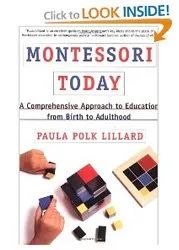My First Experience with Montessori
My wife recently changed jobs and now I am surrounded by Montessorians! Help! Now I am awash in prepared environments and sensitive periods. Good thing I’m not that sensitive! I figured I’d better find out what all the Montessori monkey business is all about.

I decided to read up on it, but unfortunately, the first book I chose, Montessori, the Science Behind the Genius by Angeline Stoll Lillard, was probably not the best one for me to start with. It’s really for scholars – as worthy a tome as it is. Angeline Lillard shows that Dr. Maria Montessori was way ahead of her time and that recent research in psychology support the practice that Montessori brought forward over 100 years ago.
 Nonetheless, I did learn a lot, although a better book to start with would have been the book written by Lillard’s mother, Paula Polk Lillard, titled Montessori Today. So what were my takeaways? Well, where to begin.
Nonetheless, I did learn a lot, although a better book to start with would have been the book written by Lillard’s mother, Paula Polk Lillard, titled Montessori Today. So what were my takeaways? Well, where to begin.

First, Montessori’s view that physical motion and movement augments cognition I found really fascinating. Montessori kids do not have to sit still at a desk for hours a day, immobile, listening to the teacher drone on an on. They are free to move about working in self-selected projects and interacting with other children. For an ex-Englishman raised in traditional English schools all my life, this was quite an eye opener.
I was fascinated by Lillards’s conclusion that schools should be designed for the optimal learning experience for the child, i.e., the needs of the child should determine the design and structure of the classroom, and not the other way around. The early development of the exercise of choice and exploration enhances learning. Next is the freedom of the child to pursue what interests him in the moment which corresponds to his developmental level or sensitive period. Lillard explains the benefits that unfold from this approach.
The sustained motivation of Montessori kids is contracted to the decreased motivation of children in a traditional classroom as they advance through the grades. Lillard explains how the ability to learn from peers and the freedom of the children to interact with one another enhances social skills.
 Learning is greatly enhanced by the child’s ability to touch and manipulate lesson materials. The child discovers the relationship of the lesson he is working on in context to what he has already learned. Learning doesn’t happen is a vacuum. Additionally, the teacher is trained to recognize the individual differences of each child and to respect how each child learns.
Learning is greatly enhanced by the child’s ability to touch and manipulate lesson materials. The child discovers the relationship of the lesson he is working on in context to what he has already learned. Learning doesn’t happen is a vacuum. Additionally, the teacher is trained to recognize the individual differences of each child and to respect how each child learns.

Finally, Montessori blends order and freedom. There is the prepared and ordered environment; but freedom within that order allows the child to develop at his or her own pace and select his own activity of interest.
I also found Lillard’s chronicling of Montessori’s teaching on concentration to be particularly significant. Montessori believed that society benefits more from the ability of its thought leaders to engage in intense levels of concentration rather than the production of a large volume of knowledge.
Albert Einstein once stated that he didn’t consider himself any smarter than anyone else, but rather he thought deeper about things longer than anyone else.
All in all Lillards’s book is a good read, but a little heavy going for the layman. As I mentioned earlier, her mother’s book, Montessori Today is probably a better place to start for the uninitiated.




















